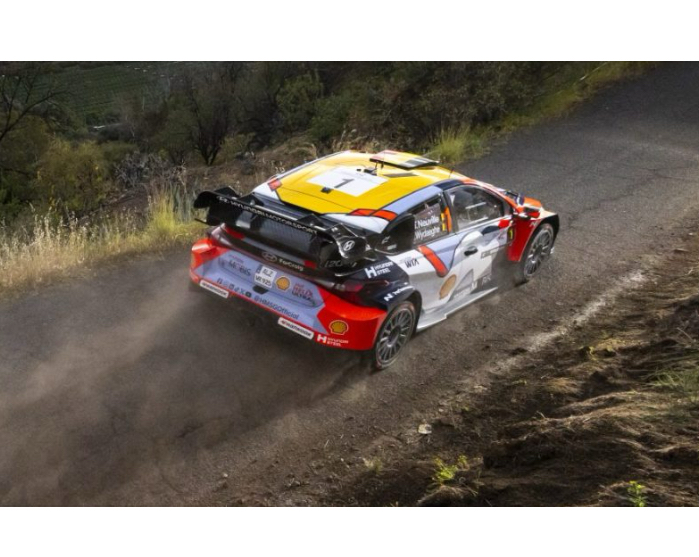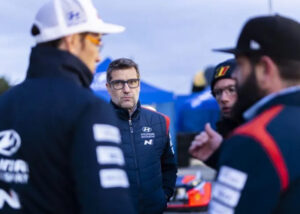In the fiercely competitive world of rally racing, where tenths of a second separate triumph from disappointment, every element of performance matters. From suspension settings to weather forecasts, no detail can be overlooked. Yet when Rally Islas Canarias 2025 kicked off with bright skies and cooler-than-expected track temperatures, it wasn’t the drivers or the weather that tilted the playing field — it was the tires.
Hankook’s latest tarmac compound, engineered for maximum peak grip and lateral consistency, delivered exactly what it promised. But for Hyundai Motorsport, it revealed something they hadn’t planned for: an intrinsic design flaw in the current i20 Rally2 chassis. Over the course of the event, Hyundai’s inability to fully unlock the new tire’s potential led to a sluggish performance that no on-site tweak could salvage.
This editorial delves into what happened in the Canary Islands — why the problem was bigger than a bad setup call, and what Hyundai must reckon with as the European rally season intensifies.
The New Hankook Tarmac Compound: A Gamechanger
Hankook’s newly introduced tarmac tire was supposed to level the field. Offering better thermal stability, a wider operational window, and a more predictable slip angle behavior, it was engineered to reward cars that could maintain steady vertical load and consistent mechanical grip.
Initial feedback from test drivers had been overwhelmingly positive. Teams across the board noted faster warm-up times, superior mid-corner stability, and less degradation on abrasive surfaces — all crucial for a fast, flowing rally like Islas Canarias, known for its technical tarmac stages and relentless cornering sequences.
But in practice, the tire’s strengths magnified certain weaknesses in car setups — punishing teams whose platforms relied on narrow operational setups or aggressive transient responses rather than pure chassis balance.
Unfortunately for Hyundai, the i20 Rally2 fell squarely into the danger zone.
Hyundai’s Core Design Philosophy: A Double-Edged Sword
Since its debut, Hyundai’s i20 Rally2 had been praised for its adaptability across surfaces. It wasn’t the outright fastest car, but it compensated with rugged dependability and a broad setup window that could handle the unpredictable nature of national and regional rally calendars.
The car’s design emphasized:
- Front-end responsiveness to maximize point-and-shoot driving on loose gravel.
- Moderate mechanical grip, relying on driver adaptability and aggressive setups to achieve peak speed.
- A tendency towards agility over neutrality, favoring drivers who thrived on quick directional changes rather than ultra-smooth arcs.
On gravel or rougher tarmac, these traits masked underlying issues. But the Hankook compound demanded a different kind of behavior: consistent load transfer, stable mid-corner attitude, and progressive steering inputs.
In this environment, the Hyundai’s design priorities became liabilities.
Early Warnings: Practice Runs and Setup Tweaks
Signs of trouble appeared almost immediately during Thursday’s shakedown stages.
While rival teams running the updated Hankooks — notably Citroën’s C3 Rally2 and Škoda’s Fabia RS Rally2 — reported significant grip improvements with relatively minor geometry changes, Hyundai crews struggled to balance the i20’s handling.
- Entry understeer was pronounced, even with aggressive differential settings.
- Mid-corner float appeared, with the rear failing to stay planted despite suspension stiffening.
- Exit instability became a persistent headache, forcing drivers to delay throttle application.
Team engineers scrambled, adjusting camber, ride heights, and anti-roll bars. But the more they tried to “fix” the behavior, the more it became clear: this wasn’t a setup issue — it was a design ceiling.
The Canary Island Curse: Stages That Punished Inconsistency
Rally Islas Canarias is notorious for its demand for relentless precision. Long, linked corners dominate the profile — demanding maximum grip throughout an entire arc, not just in bursts. Unlike gravel events where sliding can be weaponized, on Canary asphalt, any loss of contact or instability costs dearly.
With the new Hankook rubber exaggerating the mechanical demands, Hyundai found itself boxed in:
- Brake later? Risked destabilizing the rear even more.
- Carry more speed? Front grip couldn’t hold it.
- Tighten the car up? Made it too nervous, further sapping driver confidence.
Meanwhile, Škoda and Citroën cars looked surgically precise through corners, exploiting every ounce of the new tire’s stability.
By the end of Day 1, the deficit was stark. Hyundai’s best-placed car languished outside the top five, despite flawless driving from its top pilots.
Why It Couldn’t Be Fixed On-Event
In rallying, teams often adapt setups between loops or overnight services. But Hyundai faced a far deeper structural mismatch:
- Chassis Flex: The i20’s relatively softer chassis tuning, optimized for mixed-surface compliance, lacked the immediate load-bearing stiffness needed for the Hankook’s sharper lateral loads.
- Weight Distribution: Hyundai’s slightly forward-biased balance, useful on gravel, meant that under the new tires’ demands, the rear couldn’t maintain equilibrium through fast sweepers.
- Dampers and Geometry: Even with maxed-out damper settings and aggressive geometry shifts, the foundational traits could not be reversed without a redesign.
Put simply: you can tune the edges, but you can’t re-engineer the core at a service park.
Driver Feedback: Frustration Beneath the Surface
Off the record, Hyundai’s factory drivers expressed their dissatisfaction.
One summarized bluntly:
“The car wants to pivot, but the tires want a flow. We’re fighting the car instead of fighting the clock.”
Another lamented:
“On older rubber, we could hide the instability. Now? It’s on full display.”
Publicly, the team remained diplomatic, emphasizing “learning opportunities” and “valuable data gathering.” But it was obvious: the gap wasn’t due to risk aversion or driving errors — it was baked into the machinery.
Comparative Case Studies: Škoda and Citroën’s Advantage
Škoda’s Fabia RS Rally2 offers a useful contrast.
Designed with a more neutral chassis balance and higher torsional rigidity, the Fabia could fully exploit the Hankook’s capabilities. Its drivers leaned into corners with confidence, trusting the car to carry momentum without snap reactions.
Similarly, Citroën’s C3, with its sophisticated rear geometry and proven asphalt pedigree, extracted mid-corner speed that Hyundai simply couldn’t match.
This highlighted a brutal reality: Hankook’s development rewarded inherently stable, well-balanced designs. Hyundai, by optimizing for versatility rather than specialization, had left itself exposed.
Looking Ahead: Can Hyundai Recover?
Short-term fixes are unlikely.
- Setup experiments can minimize symptoms, but the fundamental mismatch between tire demands and chassis behavior remains.
- Tire management strategies — like adjusting pressure windows and heat cycling approaches — might slightly narrow the gap, but won’t eliminate it.
- Driver adaptability can rescue seconds here and there, but at this level, that margin is not enough.
The true solution lies deeper:
- Chassis revisions to improve stiffness without sacrificing too much mixed-surface compliance.
- Suspension package updates tailored specifically to high-grip tarmac conditions.
- Weight distribution tweaks to re-center the car’s dynamic balance.
Hyundai has the technical resources to evolve — but in the unforgiving tempo of rally seasons, development cycles are long, and reputations are made (or unmade) overnight.
Lessons from the Islands
Rally Islas Canarias 2025 offered a cruel but crucial lesson: in motorsport, innovations can expose more than they enhance. Hankook’s new tarmac compound pushed the boundaries of grip — and, in doing so, revealed structural truths that had been hidden in the noise.
No comments yet.









